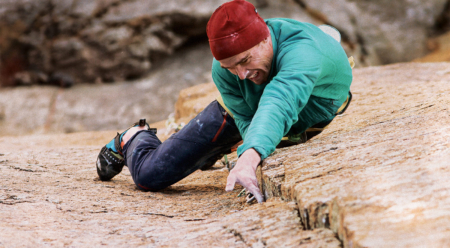The Intangible Rewards of Climbing
Digging deep to climb the three hardest routes on Longs Peak in Colorado’s Rocky Mountain National Park.
Wind pushed a wave of fine snow off the top of the wall, coating the already frosted rock in another slippery layer of spindrift. I put my head down to let it pass, looking at my fingers covered in blood and snow, and wedged into icy finger locks.
Objectively, I knew they were still there, but for most of the day I hadn’t felt them. My toes had long since become bricks of flesh in my tight rock shoes. My buddy Stanley, huddled in layers of puffy jackets down at the belay, probably wished he’d never met me. John Dickey dangled from a fixed line a few meters to my right, frantically trying to protect his camera from the elements. How did I get us into this ridiculous position?
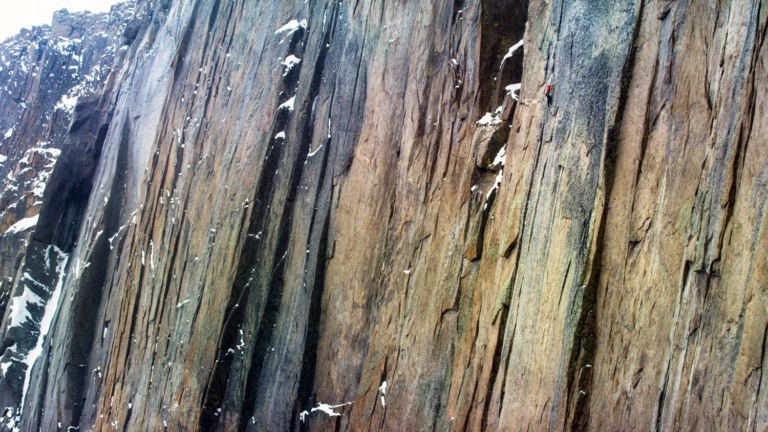
A speck of fire in a sea of cold, Josh Wharton fights his way up the stormy Dunn-Westbay Direct (5.14a at 14,000 feet). The Diamond, Longs Peak. Rocky Mountain National Park, Colorado. Photo: Chris Alstrin
Goals. I try not to take myself too seriously but I do take my climbing seriously, and when I lay out a goal for the season, I mean business. If climbing were a big-time professional sport, I would be the guy they talk about on SportsCenter who’s said to have lots of “intangibles”—really just a nice way of saying that I have little natural talent and a pea-sized brain but just enough heart and tenacity to squeak by. Climbing goals are arbitrary, with no real fame or fortune associated with success. Kim Kardashian’s jewelry is worth more than Alex Honnold’s entire portfolio, and the most famous climber in the world has less “InstaMe” followers than your average NFL kicker. But that leaves climbing goals totally absent of complicated external motivators. You answer only to yourself. Did you make smart decisions? Did you give it everything?
For the 2016 summer season, my goal was to climb the three hardest routes on Longs Peak in Colorado’s Rocky Mountain National Park: Sarcasm, a stunning, technical 5.14 arête at 12,000 feet; The Honeymoon Is Over, a king line up the proudest central wall of the Diamond, with multiple pitches of 5.13 above 13,000 feet; and the mighty Dunn-Westbay Direct (DWD), which might have one of the world’s hardest single pitches of rock climbing at altitude—an 80-meter 5.14 crux pitch. Given the five-mile approach, fickle mountain weather, common water seepage on the Diamond and the fact that I’d only climbed a handful of 5.14s in my life, calling it an ambitious goal would be an understatement.
Fortunately, unlike the hardest boulder problems or sport routes that require a level of athleticism that can’t be faked, big routes in the mountains have a weakness: They can be outsmarted and outworked. Put in enough time and thought, and the chances of success tip in your favor. With this in mind, I trained like a banshee, watched my diet and slept high on Longs Peak whenever I could to acclimate. When my 2-year-old asked if I wanted a bite of her cookie, I politely answered, “No, thank you.” Getting up at 3 a.m. to hike up to the routes became routine, but instead of stumbling back home to bed, I went straight to my garage. More training.
At first it worked. Sarcasm and The Honeymoon Is Over went down relatively quickly, but the Dunn-Westbay Direct was a different story. As the summer wore on, so did my body. As the leaves began to change, I was still failing, and badly. The crux pitch involved so many small beta details and was so near my limit. Move the left hand before the right or choose the wrong tiny nubbin for a foothold, and it was all over.
Plod home, watch for another weather window, train some more, find a friend to belay. Try again, fail again, repeat. In early September, when a previously scheduled trip to Europe took me away from Colorado, I had to concede my goal of finishing all three routes in one season.
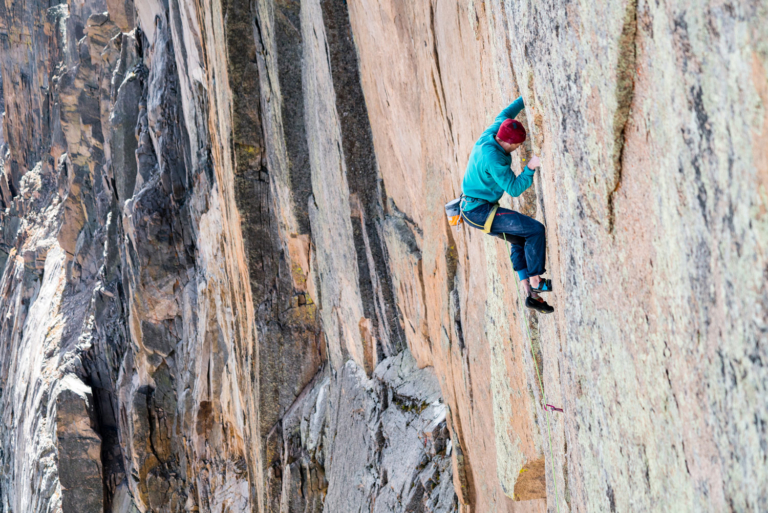
Josh Wharton, Dunn-Westbay Direct, The Diamond, Longs Peak, Rocky Mountain National Park, Colorado. Photo: John Dickey
While I was in Europe, it snowed several times in the Colorado high country, and when I came home, the ordinary approach to the Diamond via the North Chimney looked less like the chossy rock climb it normally is and more like an Alaskan alpine route. But October 10 was forecast to be sunny, with temps in the low 40s, reasonable conditions if I could try the crux pitch in a short three-hour window of sun. I’d lost some acclimatization in Europe, but what was the harm in a last-ditch effort? My friend Stanley (poor guy) agreed to belay me.
Given that the North Chimney would be a four-hour wallow at best, we decided to rappel in from the top of the route. This meant climbing, post-holing and scratching our way up the North Face to near the 14,000-foot summit, just to rap 800 feet back down the Diamond. Not exactly an energy-saving strategy.
Long before dawn, we began scrambling toward the North Face. At times the wind blew so hard that we buried our faces into our forearms, wishing for goggles. At first light, the sky glowed red. Huge clouds and waves of spindrift swept down over the Diamond. It was cold. The rock would not warm in the sun today.
The crux pitch on the DWD is a meaty and involved 80 meters of climbing, the longest single pitch of rock I’d ever tried, with all the hardest climbing concentrated in the final 40 meters. At the halfway point, a no-hands chimney stance provides a logical resting point, but in the past I’d skipped this potential belay, wanting to finish the pitch in an elegant ledge-to-ledge ascent. Today, however, I couldn’t feel a thing, and I knew going into the hardest moves with no feeling in my hands and feet surely meant failure. There’d also been lots of ice and verglas in the first half of the pitch, forcing me to make up new beta on the fly and spend far more energy than normal. Disappointed, I stopped to belay in the chimney and Stanley soon joined me.
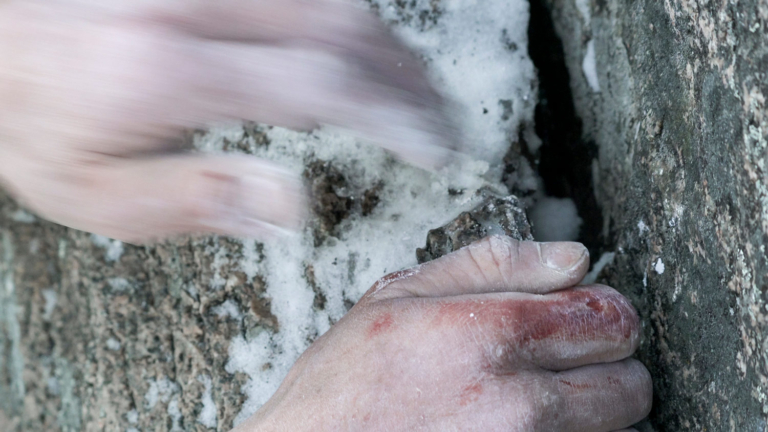
Pitch after frigid pitch, the Dunn-Westbay Direct took everything he had—right up to the ice-choked finishing jug. Photo: John Dickey
I cast off from there into 40 meters of brutal climbing with almost zero feeling in my fingers and toes. I’d run the beta through my mind a thousand times, now all that was left was execution, yet I felt separated from my limbs. The act of climbing was like operating some odd, shaky machinery. My brain would pull the arm or leg lever, and I would watch the mechanical appendage jerk to its intended spot. I’d make a quick visual inspection, confirming that the fingers or rock shoe were well-placed, then hit the “pull” or “stand” button and hope for the best. Tiny move after tiny move, the feeble machine worked. An hour later, I’d arrived at the belay without falling for the first time.
I popped the heels on my rock shoes and buried my hands in my jacket. Blood coursed back into my digits and I winced in agony. As the pain subsided, I realized what was to come: a long 5.13 pitch and another pitch of 5.12 to finish the route, and conditions were only worsening. What little sun had pierced the clouds had long gone and the east-facing Diamond was wrapped in winter shadow. The wind was strengthening, and as I climbed higher, snow poured from the top of the wall. Stanley and Dickey suffered alongside me, all of us fighting waves of punishment.
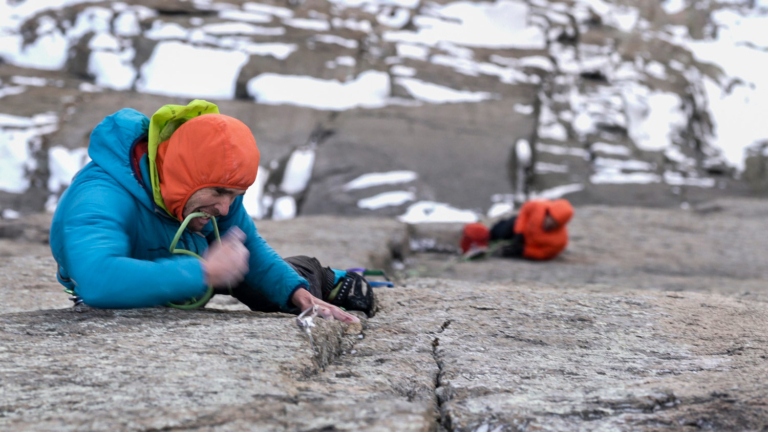
No one suffers better than Wharton. Photo: John Dickey
At a snail’s pace, I cleaned snow from holds and felt out new passages around icy cracks. Somehow I managed to free climb, operating my appendage machine with extreme caution, conserving the rapidly draining batteries wherever possible.
Finally, I crawled over the cornice atop the wall, frigid and spent. I’d made it, but my mind immediately shifted to the midpoint belay on the crux pitch. The ascent wasn’t quite right, the goal not truly complete. I’d have to go back next year. But in this moment, I also had to ask myself (since no one at SportsCenter was going to): Had I battled like never before? Had I brought all those “intangibles” to bear? Had I given it everything? For now, the answer was yes.
